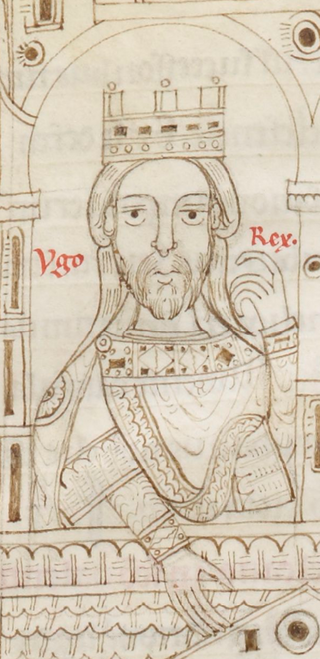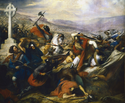
Charles the Bald, also known as Charles II, was a 9th-century king of West Francia (843–877), King of Italy (875–877) and emperor of the Carolingian Empire (875–877). After a series of civil wars during the reign of his father, Louis the Pious, Charles succeeded, by the Treaty of Verdun (843), in acquiring the western third of the empire. He was a grandson of Charlemagne and the youngest son of Louis the Pious by his second wife, Judith.

Basil I, nicknamed "the Macedonian", was Byzantine emperor from 867 to 886. Born to a peasant family in Macedonia, he rose to prominence in the imperial court after gaining the favour of Emperor Michael III, whose mistress he married on his emperor's orders. In 866, Michael proclaimed him co-emperor. Fearing a loss of influence, Basil orchestrated Michael's assassination the next year and installed himself as sole ruler of the empire. He was the first ruler of the Macedonian dynasty.

Louis II, sometimes called the Younger, was the king of Italy and emperor of the Carolingian Empire from 844, co-ruling with his father Lothair I until 855, after which he ruled alone.

Leo VI, also known as Leothe Wise, was Byzantine Emperor from 886 to 912. The second ruler of the Macedonian dynasty, he was very well read, leading to his epithet. During his reign, the renaissance of letters, begun by his predecessor Basil I, continued; but the empire also saw several military defeats in the Balkans against Bulgaria and against the Arabs in Sicily and the Aegean. His reign also witnessed the formal discontinuation of several ancient Roman institutions, such as the separate office of Roman consul.

Louis the Blind was the king of Provence from 11 January 887, king of Italy from 12 October 900, and briefly emperor between 901 and 905. His father was a Bosonid and his mother was a Carolingian. He was blinded after a failed invasion of Italy in 905.
Richard the Justiciar (858–921), also known as Richard of Autun, was count of Autun from 880 and the first margrave and duke of Burgundy. He attained suzerainty over all the counties of Burgundy save Mâcon and by 890 he was referred to as dux (duke) and by 900 as marchio (margrave). By 918 he was being called dux Burgundionem or dux Burgundiae, which probably signified less the existence of a unified Burgundian duchy than feudal suzerainty over a multiplicity of counties in a specific region.

Hugh, known as Hugh of Arles or Hugh of Provence, was the king of Italy from 926 until his death. He belonged to the Bosonid family. During his reign, he empowered his relatives at the expense of the aristocracy and tried to establish a relationship with the Byzantine Empire. He had success in defending the realm from external enemies, but his domestic habits and policies created many internal foes and he was removed from power before his death.

Boso was a Frankish nobleman of the Bosonid family who was related to the Carolingian dynasty and who rose to become King of Lower Burgundy and Provence.

The Kingdom of Lower Burgundy, also called Cisjurane Burgundy, was a historical kingdom in what is now southeastern France, so-called because it was lower down the Rhône Valley than Upper Burgundy.

The Macedonian dynasty ruled the Byzantine Empire from 867 to 1056, following the Amorian dynasty. During this period, the Byzantine state reached its greatest extent since the Early Muslim conquests, and the Macedonian Renaissance in letters and arts began. The dynasty was named after its founder, Basil I the Macedonian who came from the theme of Macedonia.
Charles-Constantine was a Count of Vienne. His father, Louis the Blind, was King of Provence and Holy Roman Emperor.
Boso was a Burgundian nobleman who spent much of his career in Italy, where he became Margrave of Tuscany about 932. He ruled semi-autonomously and was a benefactor of the churches of his region. He lost his office in 936 and probably returned to Burgundy.
Engelberga was the wife of Emperor Louis II and thus Carolingian empress to his death on 12 August 875. As empress, she exerted a powerful influence over her husband.
The Bosonids were a dynasty of Carolingian era dukes, counts, bishops and knights descended from Boso the Elder. They married into the Carolingian dynasty and produced kings and an emperor of the Frankish Empire.

Bernard Plantapilosa or Bernard II of Auvergne, or Plantevelue, son of Bernard of Septimania and Dhuoda, was the Count of Auvergne from 872 to his death. The Emperor Charles the Fat granted him the title of Margrave of Aquitaine in 885.
Zoe Zaoutzaina was a Byzantine empress consort as the second wife of the Byzantine emperor Leo VI the Wise. She was the daughter of Stylianos Zaoutzes, a high-ranking bureaucrat during the reign of her husband.
The Emirate of Bari was a short-lived Islamic state in Apulia, in what is now Italy, ruled by non-Arabs, probably Berbers and Black Africans. Controlled from the South Italian city of Bari, it was established about 847 when the region was taken from the Byzantine Empire, but fell in 871 to the army of the Carolingian emperor Louis II.

Constantine was a junior Byzantine emperor, alongside Basil I as the senior emperor, from January 868 to 3 September 879. His parentage is a matter of debate, but historians generally assume him to be the son of Emperor Basil I and his first wife Maria or second wife Eudokia Ingerina; other theories include him being the son of Emperor Michael III and Eudokia. Constantine was made co-emperor by Basil in c. January 868. He was engaged to Ermengard of Italy, the daughter of Holy Roman Emperor Louis II, in 870/871, but it is not known if he married her; some sources suggest he did, and others argue that there is no concrete evidence.

The Frankish emperor Louis II campaigned against the Emirate of Bari continuously from 866 until 871. Louis was allied with the Lombard principalities of southern Italy from the start, but an attempt at joint action with the Byzantine Empire failed in 869. In the final siege of the city of Bari in 871, Louis was assisted by a Slavic fleet from across the Adriatic.
Engelberga of Provence, Duchess of Aquitaine (877–917) was a 8th-9th century Bosonid noblewoman.
















